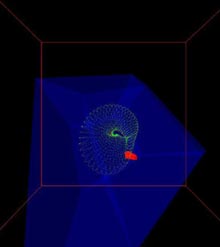Physicist Drops Work Experience Kids into a 4 Dimensional Hypercube

A two dimensional picture of a 4D Hypercube <br>© Warwick University Press Office
When you are sent to do a bit of work experience in the office of a university science department you don’t normally expect much more than a bit of boring filing and some tedious photocopying. So those that turned up to the University of Warwick’s Physics department recently were a bit shocked to be taken to a small black room and dropped into a virtual reality four dimensional hypercube.
Instead of dreary photocopying the work experience kids were used to help University of Warwick physicist Richard Wellard solve the major problem of how to rotate a four dimensional object- a hyper cube- in the three dimensions of a virtual reality simulator.
Everyone has seen the classic two dimensional wire frame drawing of a three dimensional cube. It is also even possible to produce a two dimensional picture of a 4D Hypercube (it looks like a cube within a cube). However until now researchers have found it difficult to get their three dimensional virtual reality systems to display and rotate a 4D dimensional hypercube without straining the viewer’s understanding of how to manipulate the image well beyond the ability of most people.
Richard Wellard’s new system allows simple movements of a virtual reality wand to rotate 4D hypercubes with such ease that it took only an hour to train, the quiet literally inexperienced, work experience kids to rotate the 4D hypercube in precise ways.
Why would anyone want to rotate a 4D hypercube anyway? Richard Wellard believes it will be an invaluable tool for anyone trying to explain, teach or research the difficult field of 4 dimensional objects such as the Klein bottle – a one-sided closed surface that cannot be constructed in normal space. It is most commonly pictured as a cylinder looped back through itself to join with its other end.
It will also prove useful to anyone trying to find patterns in data which involves plotting four different variables. Researchers will be able to use virtual reality systems to plot such data on a four dimensional virtual reality graph which they can then rotate to search for patterns in the data.
For further details contact:
Richard Wellard
email: Wellard@astro.warwick.ac.uk
Dept of Physics, University of Warwick
Tel: 07985 377718
Media Contact
All latest news from the category: Physics and Astronomy
This area deals with the fundamental laws and building blocks of nature and how they interact, the properties and the behavior of matter, and research into space and time and their structures.
innovations-report provides in-depth reports and articles on subjects such as astrophysics, laser technologies, nuclear, quantum, particle and solid-state physics, nanotechnologies, planetary research and findings (Mars, Venus) and developments related to the Hubble Telescope.
Newest articles

A universal framework for spatial biology
SpatialData is a freely accessible tool to unify and integrate data from different omics technologies accounting for spatial information, which can provide holistic insights into health and disease. Biological processes…

How complex biological processes arise
A $20 million grant from the U.S. National Science Foundation (NSF) will support the establishment and operation of the National Synthesis Center for Emergence in the Molecular and Cellular Sciences (NCEMS) at…

Airborne single-photon lidar system achieves high-resolution 3D imaging
Compact, low-power system opens doors for photon-efficient drone and satellite-based environmental monitoring and mapping. Researchers have developed a compact and lightweight single-photon airborne lidar system that can acquire high-resolution 3D…





















